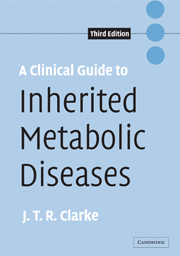Book contents
- Frontmatter
- Contents
- Reviews of first edition
- Reviews of second edition
- List of tables
- List of figures
- Preface
- 1 General principles
- 2 Neurologic syndrome
- 3 Metabolic acidosis
- 4 Hepatic syndrome
- 5 Cardiac syndromes
- 6 Storage syndrome and dysmorphism
- 7 Acute metabolic illness in the newborn
- 8 Newborn screening
- 9 Laboratory investigation
- 10 Treatment
- Index
- References
9 - Laboratory investigation
Published online by Cambridge University Press: 10 September 2009
- Frontmatter
- Contents
- Reviews of first edition
- Reviews of second edition
- List of tables
- List of figures
- Preface
- 1 General principles
- 2 Neurologic syndrome
- 3 Metabolic acidosis
- 4 Hepatic syndrome
- 5 Cardiac syndromes
- 6 Storage syndrome and dysmorphism
- 7 Acute metabolic illness in the newborn
- 8 Newborn screening
- 9 Laboratory investigation
- 10 Treatment
- Index
- References
Summary
It is impossible to exaggerate the importance of the diagnostic clinical chemistry laboratory in the investigation of inherited metabolic diseases. Access to comprehensive routine laboratory testing is indispensable to the establishment of the diagnosis of any suspected inherited metabolic condition, and the clinical biochemist is an extremely important collaborator whose allegiance should be cultivated carefully. In this chapter, I present information relating to the laboratory investigation of inherited metabolic diseases to help the clinician understand some of the technical principles involved, to give enough detail about certain tests to provide a feel for the interpretation of test results, and some of the more common sources of error. It is not intended to be a detailed technical treatise on clinical chemistry. However, I have found that the initial laboratory investigation of patients with possible inborn errors of metabolism is generally more appropriate when the clinician has some understanding of laboratory issues. Treating some of the diagnostic laboratory information in a separate chapter like this does create its own problems. Specifically, it is difficult at times to decide whether a particular point should be included here, or if it would not be more logically placed alongside of the presentation of the clinical aspects of a particular disease. This has been resolved in most cases by a compromise. If the laboratory aspects of, for example, amino acid analysis, are relevant to more than one major clinical presentation, such as chronic encephalopathy (covered in Chapter 2), metabolic acidosis (Chapter 3), and hepatocellular dysfunction (Chapter 4), it seemed more appropriate to place it in a separate chapter.
- Type
- Chapter
- Information
- A Clinical Guide to Inherited Metabolic Diseases , pp. 241 - 296Publisher: Cambridge University PressPrint publication year: 2005

